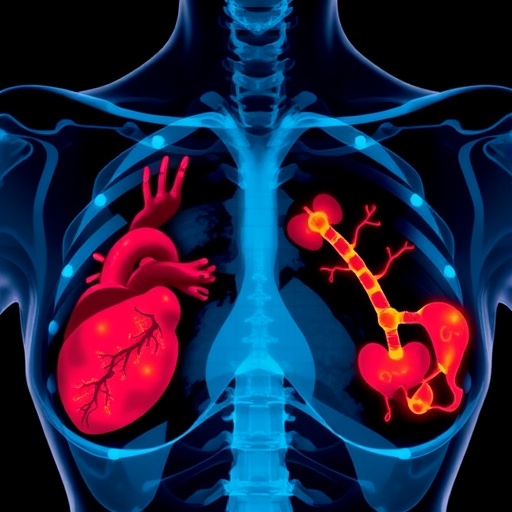In a groundbreaking advancement at the intersection of cardiovascular health and breast cancer screening, researchers at The George Institute for Global Health have developed a machine learning model capable of accurately predicting heart disease risk in women by analyzing routine mammograms. This innovative application of deep learning capitalizes on mammographic imagery—already widely used for breast cancer detection—to concurrently assess cardiovascular risk, addressing a longstanding gap in women’s health diagnostics. The study detailing this breakthrough has been published in the upcoming September 2025 issue of Heart, the official journal of the British Cardiovascular Society.
Traditional cardiovascular risk assessment models typically rely on multifaceted clinical data, including blood pressure, cholesterol levels, smoking status, and medical histories. However, these approaches often under-serve women, who are less likely to be screened or appropriately diagnosed for cardiovascular disease (CVD), despite CVD being a leading cause of mortality among women worldwide. Recognizing this disparity, the team leveraged an existing, widely accepted screening modality—mammography—to develop a model integrating age and mammographic features using deep learning algorithms, therefore simplifying and streamlining cardiovascular risk evaluation.
This pioneering model was constructed and validated using a robust dataset comprising over 49,000 mammograms collected from women residing in both metropolitan and rural regions of Victoria, Australia. These imaging data sets were linked to comprehensive individual hospital and mortality records, allowing for precise correlation with major adverse cardiac events. This extensive linkage enables the model to learn complex imaging biomarkers predictive of cardiovascular risk, surpassing the limitations of prior research that mainly focused on singular features like breast arterial calcification (BAC).
Breast arterial calcification has been studied in the past as a mammographic biomarker with some association to cardiovascular outcomes. However, its predictive power diminishes significantly in older women and when used in isolation. The new machine learning framework overcomes these shortcomings by analyzing a diverse array of mammographic characteristics combined with patient age, thereby enhancing predictive accuracy without the need for additional clinical inputs. This makes the approach less resource-intensive and more adaptable for population-scale implementation, especially within communities where access to comprehensive clinical evaluations is limited.
Associate Professor Clare Arnott, Global Director of the Cardiovascular Program at The George Institute, emphasized the clinical importance of this research, noting that cardiovascular disease in women frequently goes undetected and untreated. She highlighted that integrating cardiovascular risk screening into routine breast cancer screening programs could drastically improve early identification and prevention efforts by leveraging an already familiar healthcare touchpoint for many women. Such an approach holds transformative potential to simultaneously address two leading causes of morbidity and mortality: breast cancer and cardiovascular disease.
From a technical standpoint, the research team employed advanced computational simulation and modeling techniques to train their deep learning system. This system extracts subtle imaging features—beyond what is visible to the human eye—and correlates them with clinical outcomes. The model’s performance was rigorously benchmarked against established cardiovascular risk calculators that depend on traditional risk factors, demonstrating comparable accuracy. This equivalence affirms that mammographic imagery contains rich, underutilized data reflective of vascular health, which can be unlocked through modern artificial intelligence methodologies.
Dr. Jennifer Barraclough, a Research Fellow involved in the study, pointed out that utilizing routine mammograms eliminates logistical barriers typical of cardiovascular screening in geographically diverse populations. Mobile mammography units, already operating free of charge in rural Australia, present an ideal platform for deploying this technology and delivering equitable healthcare access. The researchers foresee that their machine learning tool could soon be scaled globally, adapting to the mammographic data available in diverse healthcare systems, thereby democratizing cardiovascular risk prediction at a population level.
The implications of this research extend beyond immediate clinical applications. It challenges existing paradigms in cardiovascular risk assessment by demonstrating that non-traditional imaging modalities contain valuable prognostic information retrievable through machine learning. This breakthrough encourages the reevaluation of existing screening programs and promotes interdisciplinary collaboration between oncologists, cardiologists, radiologists, and data scientists to maximize patient outcomes.
Despite the promising results, the authors acknowledge that further validation is essential. Ongoing efforts aim to test the model across diverse populations with different ethnic and sociodemographic backgrounds to ensure generalizability and to identify potential barriers to clinical integration. Understanding these factors will be critical to transitioning the model from research into routine clinical use, where it could revolutionize preventive cardiology by enhancing early risk stratification in women.
The sizeable Lifepool cohort, created by the Peter MacCallum Cancer Centre along with the University of Melbourne and Royal Melbourne Hospital, underpins this research. Since its establishment in 2009, Lifepool has enrolled over 54,000 women across metropolitan and rural Australia, serving as an invaluable resource for longitudinal breast health research. This extensive, well-characterized dataset provided the foundation for linking mammographic features with cardiovascular outcomes essential for training and validating the machine learning model.
In summary, this innovative study convincingly demonstrates that routine mammograms hold untapped potential for cardiovascular risk prediction in women, offering a dual-purpose screening tool that could transform public health strategies. By harnessing the power of deep learning, the research not only addresses the historic underdiagnosis of cardiovascular disease in women but also optimizes existing healthcare infrastructure to provide equitable, efficient, and accurate screening. As healthcare systems worldwide face escalating burdens from chronic diseases, such interdisciplinary technological advances may herald a new era in precision preventive medicine.
Subject of Research: People
Article Title: Predicting cardiovascular events from routine mammograms using machine learning
News Publication Date: 16-Sep-2025
References:
Barraclough J, et al. Predicting cardiovascular events from routine mammograms using machine learning. Heart. 2025.
Allen TS, Bui QM, Petersen GM, Mantey R, Wang J, Nerlekar N, et al. Automated Breast Arterial Calcification Score Is Associated With Cardiovascular Outcomes and Mortality. JACC: Advances. 2024;3(11):101283.
Di Cesare M, et al. The heart of the world. Global heart. 2024.
Al Hamid A, et al. Gender Bias in Diagnosis, Prevention, and Treatment of Cardiovascular Diseases: A Systematic Review. Cureus. 2024.
Centers for Disease Control and Prevention. Health, United States, 2020-2021: National Center for Health Statistics; 2021.
Deandrea S, Molina-Barceló A, Uluturk A, Moreno J, Neamtiu L, et al. Presence, characteristics and equity of access to breast cancer screening programmes in 27 European countries in 2010 and 2014. Preventive Medicine. 2016;91:250-263.
Web References:
DOI: 10.1136/heartjnl-2025-325705
Keywords: Cardiovascular disease; Mammography; Risk factors; Deep learning; Diagnostic imaging
Tags: addressing gender disparities in healthadvancements in cardiovascular researchAI in healthcarecardiovascular disease mortality in womendeep learning in medical imaginginnovative heart disease predictionintegrating mammography with heart healthmachine learning cardiovascular risk assessmentmammogram analysis for heart diseasepredictive algorithms for womenroutine mammograms and CVDwomen’s health diagnostics





